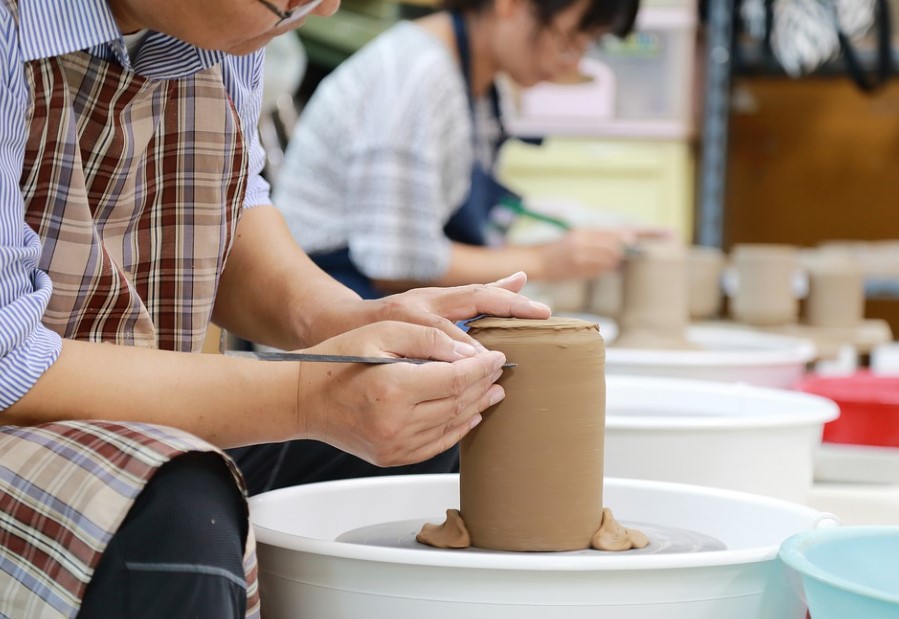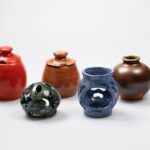Do you consider yourself to be good with your hands and enjoy working with clay? Then pottery sounds like the right fit for you. Pottery is a popular hobby and though it takes dedication, patience a lot of hard work, and focus, chances are you’ll soon be making your own little creations. So today we’ll be telling you about how to do pottery at home.
While you may be tempted to take a pottery course, which you should at some point, you can actually begin to make your own art without having to leave your home. If you must know is great for relieving stress it is also a great way for you to make use of your time in a more efficient manner. You do need to bear in mind that besides the willingness to create something out of clay, you will also be needing at least the minimum equipment to get you on the right track.
Though it may sound terrifying at first, pottery is a cool way to take on a new challenge and who off your skills, and even see how far can you go. Think of all the things you’ll want to make and even gift them to someone special. Whether you are new to pottery or not, if you wish to know how to do pottery at home you are in the right place.
How to Do Pottery at Home FAQs
Is pottery a good hobby?
The materials and tools required to make pottery pieces can be costly. There is also trial and error involved in the process. Pottery is a great hobby for people who have a true passion and are willing to learn.
Is pottery hard to learn?
It’s not exceptionally hard. Learning the basic premise of throwing can be achieved in about 5-week of class.
Why make pottery at home?
Making pottery at home is a fun activity that everyone in the family can enjoy. Whether you are looking to start making pottery as a hobby or professionally, the first thing you’ll need to do to start making ceramics at home is to get the right materials and equipment.
Can you make pottery at home without a kiln?
When firing without a kiln, it may help to pre-dry your clay pieces in a kitchen oven set to 190 degrees F. With a kitchen oven, the pots are dried by “baking” below the boiling temperature of water for several hours.
Is it possible to do pottery at home?
Although you can technically start making pottery at home with just clay, a pottery wheel, and a kiln, there are endless tools that can help you create more precise, well-shaped, and professional-looking pieces.
How much does a small kiln cost?
Within the $750 – $1500 price range, Soul Ceramics offers the Evenheat High Fire 1210B for $1,375.99 and the Jen-Ken AF3C 11/9 for $907.99. Both of these are smaller, top-loading kilns ideal for small pieces.
How much is a potters wheel?
No matter the model you chose, all pottery wheels are an investment, but generally, they range in price from just over $400 to almost $1,500.
Can you make pottery without a wheel?
Potters and ceramic artists use different pottery-making techniques depending on the kind of items they want to make. If you want to make pottery at home, you can absolutely do it without a pottery wheel, but beware that you will be limited to creating objects based on molds or entirely shaped by hand, which will most likely result in pieces with imprecise and uneven looks.
Can you fire pottery in an oven?
You cannot fire pottery clay in an oven because you cannot get high enough temperatures although you can fire pottery in an oven and that would be the way I would recommend if you have small children.
What do you need to start making pottery at home?
Regardless of the kind of objects you want to make, there are basic items you’ll need to buy to get started.
Clay
Is nothing but fine-grained earth that can be shaped when wet. It contains sand, minerals, tiny rocks, and other natural soil components in different concentrations. It comes in a variety of textures and colors depending on its particle size and composition.
5lb Pottery Clay
BMX (Best Mix) Clay is great for a wide variety of glazes. It ranges in firing color from a soft white to a light gray color, perfect for the wheel or hand-building projects.
If you are searching for a light white throwing body that is easy to use and accepts a wide range of your own glaze formulas or commercial glazes, then this is the clay for you.
It is blended with the optimum percentage of clays and raw materials to achieve a silky soft white (no iron spots) clay that can be used on the wheel or with hand-building operations.
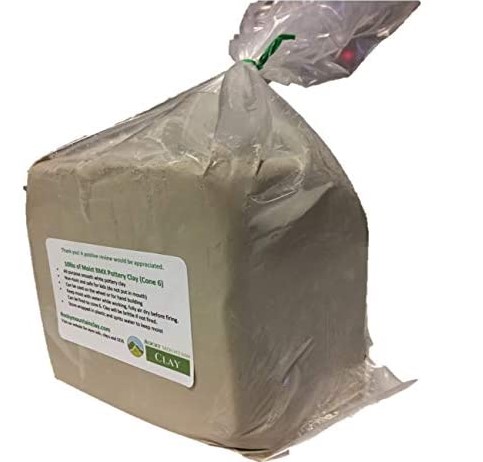
Features:
- White, Grey
- Smooth
- Non-Toxic
Pottery Wheels
If you are planning on making pottery at home more than once and especially any kind of round ceramic ware like pots, cups, plates, or jugs, it is recommended to get a pottery wheel so you can unleash your imagination and create as many pieces as you want, the right way.
VEVOR Pottery Wheel Ceramic
Upgraded with an LCD screen, you can monitor and adjust the work speed, control the direction of the turntable, and switch between 2 operation modes (manual/foot pedal) simply by touching keys on the display panel.
Waterproof LCD screen for the touch even with clay on your hands. The aluminum alloy adopted by this 9.8″ / 25 cm turntable is not easy to corrode and rust.
Premium ABS water basin is detachable for efficiently cleaning. The machine body is of spray treatment, and a compact structure with humanized design and excellent details provides you with a more enjoyable mood.
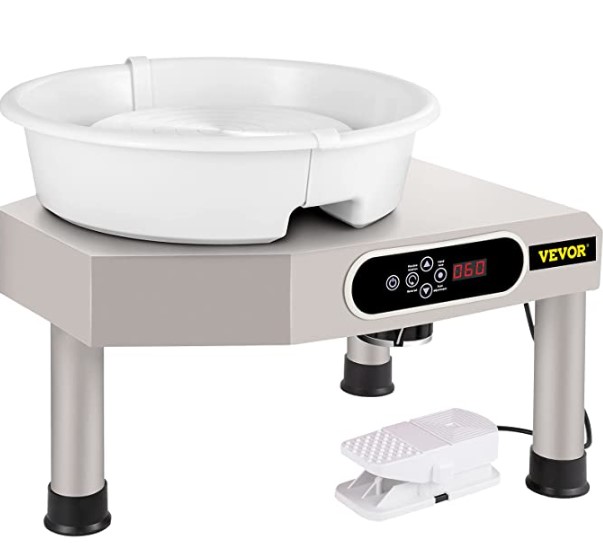
Features:
- Foot Pedal
- Detachable ABS Basin
Kilns
Kilns are a type of oven capable of producing temperatures high enough to fire things like pottery and bricks; it simply dries the clay and turns it into ceramics once you’re done shaping it.
One way or another, clay needs to be fired so it is recommended you get a kiln to do so. Kitchen ovens don’t get hot enough to fire pottery. You can always pit fire clay at home
Melting Furnace RapidFire Tabletop Kiln
The RapidFire offers the ultimate combination of portability, function, and performance demanded by professional artists, at a fraction of the cost.
This furnace cannot be used for wax/resin burnout procedures. Please see our Hi-Temp wax burnout model for this application! This kiln is also not suitable for glass melting.
Designed with a digital temperature controller (1500 watts of power) to handle multiple projects. Weighs just 12 lbs, ultra-portable with a carrying handle.
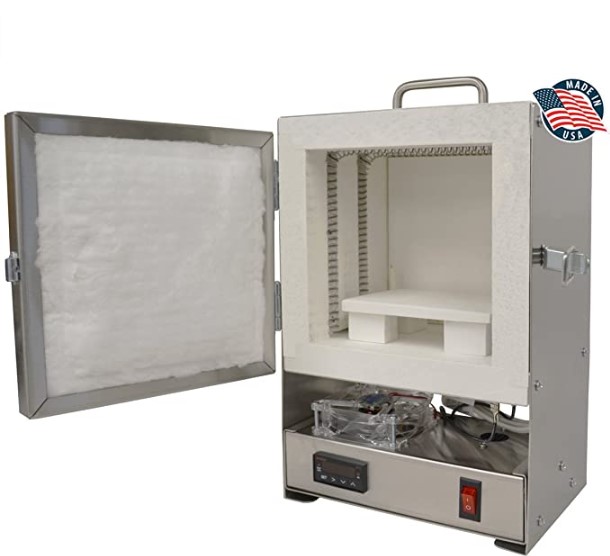
Features:
- Portable
- Carrying Handle
Tools
- Needles: Used for measuring thickness, carving, trimming, and piercing clay.
- Cutter wire: Used for dividing large blocks of clay into chunks.
- Ribbon tools: Used for trimming and carving when shaping clay by hand.
- Scrappers: Used for final smoothing of the pieces.
- Fettling Knives: They are very versatile, they can be used to separate molds, trim, pierce, carve, sculpt and even cut chunks of clay.
- Chamois cloth: Used to compress the clay while it’s on the wheel to create smooth surfaces.
- Calipers: Used to measure the distance between two opposite sides.
- Brushes: Used for a variety of purposes but especially for glazing or applying slip.
- Sponges: Used for shaping and cleaning surfaces.
- Other modeling tools depend on the exact pieces you’d want to make.
- Towels and aprons: Making pottery at home can get messy. A few towels and an apron will help you keep yourself and your space as clean as possible.
Blisstime Set of 42 Clay Sculpting Tool Kit
42 pieces in total: contain most of the clay tools you will need, great for carving, shaping, modeling, cutting, scraping, brushing, smoothing, and so on.
Keep your pottery tools organized with this strong zip-up case. Individually stored to make it easy to find the right tool at a glance and gives you compact storage for keeping at home or in your studio, and is ideal for bringing your equipment to pottery class.
Double-sided design for a variety of shapes and uses, make your work more flexible.

Features:
- Smooth
- Durable
- Lightweight
Glaze and other materials
Glaze and paints should be enough to get you started at home. Glazing is one of the most common and easiest decorating techniques. The glaze is a liquid, very much like paint, that gives ceramics a smooth, glass-like surface. It comes in any color and it’s used to decorate and waterproof pieces. And, when it comes to paints, liquid latex or acrylic paints are the best for decorating pottery at home.
What are the types of clay?
- Stoneware clay is the most versatile and easiest to work with. It comes in a variety of colors from white to dark brown. Once fired, stoneware clay is non-porous, which means it’s capable of holding liquid without having to glaze it.
- Earthenware tends to be thicker, and heavier but weaker than stoneware. It’s also easy to work with but it needs to be glazed if you want your pottery to be permeable. This extra step requires extra time and materials, which might not be ideal for beginners.
- Porcelain clay is quite difficult to shape and requires a generous amount of water that needs to be strategically added to the mix while shaping it. If you don’t add enough water it quickly dries out and if you add too much water it can easily lose its shape and collapse.
How to Do Pottery at Home
Using a Potter’s Wheel
- Making pottery with a potter’s wheel is called wheel throwing, or throwing on the wheel. Here is a simple outline of what throwing pottery on the wheel involves.
- It is a whistle-stop tour of wheel throwing. This brief outline will give you an idea of what is involved. So, you can decide if it appeals to you as a way of making pottery.
Hand Building Pottery
Hand-building pottery is exactly as it sounds. You are using your hands to build the clay into pottery vessels. There are 4 main ways of hand-building:
- Slab Pottery: With slab pottery, you are building your vessels out of slabs of clay. The main technique involved is to roll out slabs of clay and join them together into the desired shape.
- Pinch Pottery: The pinch pottery technique involves using your fingers and thumb to pinch your clay into the desired shape.
- Coil Pots: Making coil pottery is an ancient art form dating back thousands of years. It involves rolling clay out into long coils of clay and then shaping these together to form a vessel.
- Hump Molds: A hump mold is basically a hump over which a slab of clay can be draped and shaped. Humps can be made out of different materials. They can be made out of bisque pottery, wood, plaster, or even plastic.
Slip Casting
- Slip casting doesn’t involve molding clay. Instead, it involves pouring liquid clay or clay slip into plaster molds. Water from the clay slip is absorbed by the plaster and the clay hardens into the shape of the mold.
- The plaster molds are normally made out of casting plaster. You can either buy these molds, or you can make them.
- A lot of molds used for slip-cast pottery consist of two halves that fit together. This means that when the clay slip has become leather hard, the two parts can be taken apart. This enables the cast pottery to be removed easily.
- Once the cast pottery is removed, any excess clay or seam lines can be tidied up.
- The beauty of slip casting is that you can create very smooth pieces of pottery. And you can replicate these pieces very precisely.
Additional Tips
- Have a Dedicated Space to Make Pottery at Home. You will need to buy yourself a few tools and have some space for the things you make. So, having a space that is dedicated to making pottery will help.
- Shelving is essential if you want to make pottery at home. Although you don’t need a lot of complicated equipment, you will need a little space to store some items.
- It’s important to clear up after you have made pottery. Clay dust is not good to have to linger around on surfaces, so it’s important to wipe it down afterward.
- It’s a good idea to wear comfortable clothes that you can wash regularly. Even if you wear an apron, you will probably end up with blobs of clay on your clothing.

